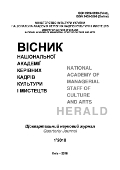CONFRONTATION OF THE BASIC CONCEPTS OF ISLAMIC MYSTICISM AND POST-STRUCTURALISM PHILOSOPHY IN ARCHITECTURE WITH EMPHASIZING ON RUMI & JACQUES DERRIDA’S VIEWS
DOI:
https://doi.org/10.32461/2226-3209.1.2018.178795Анотація
Abstract. What the West and its theorists now call "deconstruction", have practically gone their way through Iranian culture and literature. Particularly contemplating the mystical texts makes the subject clearer. In this research, we intend to use a descriptive-analytical method to study the comparative fundamental concepts of Islamic mysticism and post-structuralism philosophy in architecture, with emphasis on Rumi and Jacques Derrida's ideas. The objectives of such a study to the reader can be very strange. Because the subject is the study of two thoughtful who belong to the two very different
traditions. The significance of this issue will be manifested in such a way that, as a result of this new movement toward mysticism and spirituality, Islamic mysticism can also review its relationship with philosophy, in particular its relationship with the anti-fundamentalist philosophy of the West which is one of the best ways of connecting Islamic mysticism to the new discussions of Western philosophy. The results of this study indicate that the fundamental concepts of Rumi and Jacques Derrida's intellectual mechanism are in principle compatible with each other. Among these common principles, can
point to uncertainty, relativism, decentralize, binary opposites, hermeneutic and the death of the author. In addition to the common concepts in Rumi and Derrida’s intellectual mechanism, one point that is very contemplative is that both mysticism and deconstruction in an infinite belief will perplex the audience; because it is only in this status that you can pass away from yourself and look at the others.
Keywords: Mysticism; Philosophy; Post-structuralism; Deconstruction; Rumi; Derrida.
Посилання
Kakarash, F. (2009). Derrida's semiotics in Rumi's poems emphasizing on deconstruction, Islamic Mystic Journal, No.
, Winter.
Hamedani, O. (2008). Mysticism and Thinking; From Rumi's mystical insights to mystical elements through Heidegger's
thinking (analytical-critical analysis), Tehran, Contemporary Vison Press.
Ahmadi, B. (2001). The text-structure and textural interpretation, Tehran, Center Press.
Binazir, N. (2014). Deconstruction and Mysticism: possibility or refusal (Relying on Derrida and Maulana thought), Journal of
Literature Studies, No. 29, Autumn.
Gheituri, A. & Taheri, H. & Mirzaee, J. (2008). Derrida and Mowlavi on Philosophers Reason. Wisdom and Philosophy Journal.
Vol. 3. No.4. February.
Bolandian, M. & Naseri, S. (2014). Refreshing Islamic Sufism Symbolic Meanings in Narrative Texts and Reflection on the
Spatial Fabric of Cities. Urban Management Journal. No. 35. Summer.
Noghrekar, A. (2014). An Impression of Islamic Wisdom in Art and Architecture, Tehran, New Thought Press.
Anaghe, A. & Mahmoudian, H. & Saberizade, R. (2011). Manifestation of Mysticism in the Architecture of the Mosque, Islamic
Mysticism Journal, No. 33, Vol. 9, Autumn.
Memarian, G. (2005). Theoretical Foundations of Architecture, Tehran, Sorosh Press.
Ardalan, N. & Bakhtiar, L. (2000). The Sense of Unity: The Sufi Tradition in Persian Architecture, USA, Kazi
Publications.
Ghoyumi, M. (2012). The Relationship between Place and the Human in Masnavi, Rumi Research Journal, No. 4,
Winter.
Pishvaie, H. & Ghoyumi, M. (2013). Soil and Wisdom, Iranian Architectural Studies Journal, No. 3, Spring and
Summer.
Hedayati, M. (2015). Mystic House, Master's thesis, Department of Architecture and Urban Planning, Mazandaran,
Pardisan University.
Chittick, W. (2003). The Sufi Docturine of Rumi: An Introduction, Tehran, Peykan Press.
Schimmel, A. (1993). The Triumphal Sun: A Study of the Works of Jalaloddin Rumi, USA, Suny Press.
Rumi, J. (1999). Fihi Ma Fihi, USA, Shambhala Press.
Ansari, H. (2004). The Influence of Derrida’s Thoughts on Architecture, Fine Art Journal, No. 18, Summer.
Ghobadian, V. (2016). Theories and Concepts in Contemporary Western Architecture, Tehran, Cultural Research
Bureau.
Eghbali, R. (2007). The Roots of Deconstructivism in Philosophy, Art and Architecture, Fine Arts Journal, No. 30,
Summer.
Fakhri, L. (2004). The Death of Deconstructive Philosopher, Hamshahri Newspaper, No. 2941, October.
Derrida, J. (1976). Of Grammatology, (Translated by: Gayatri Chakravorty Spivak) Johns Hopkins University Press,
Baltimore.
Eisenman, P. (1989). Peter Eisenman Versus Leon Krier, Architectural Design, Vol 59, 910.
Papadakis, A. & Catherine, C. & Andrew, B. (1989), Deconstruction Omnibus Volume, London, Academy Editions,
Wiley Publication.
Hart, K. (1989). The Trespass of the Sign: Deconstruction, Theology and Philosophy, Cambridge, Cambridge
University Press.
Almond, I. (2003). The Shackles of Reason: Sufi / Deconstructive Opposition to Rational Thought, Philosophy East and
West.
Caputo, J. D. (1997). The Prayers and Tears of Jacques Derrida: Religion without Religion, Bloomington and
Indianapolis: Indiana University Press.
Almond, I. (2002). The Honesty of Perplexed: Derrida and Ibn Arabi on Bewilderment, Journal of the American
Academy of Religion.
Almond, I. (2004). The Meaning of Infinity in Sufi and Deconstructive Hermeneutics: When Is an Empty Text an
Infinite One, Journal of The American Academy of Religion.
http://www.muslimheritage.com/article/mosque-of-whirling-colours
##submission.downloads##
Номер
Розділ
Ліцензія
Автори, які публікуються у цьому журналі, погоджуються з наступними умовами:
1. Автори залишають за собою право на авторство своєї роботи та передають журналу право першої публікації цієї роботи на умовах ліцензії Creative Commons Attribution License International CC-BY, котра дозволяє іншим особам вільно розповсюджувати опубліковану роботу з обов'язковим посиланням на авторів оригінальної роботи та першу публікацію роботи у цьому журналі.
2. Автори мають право укладати самостійні додаткові угоди щодо неексклюзивного розповсюдження роботи у тому вигляді, в якому вона була опублікована цим журналом (наприклад, розміщувати роботу в електронному сховищі установи або публікувати у складі монографії), за умови збереження посилання на першу публікацію роботи у цьому журналі.
3.Політика журналу дозволяє і заохочує розміщення авторами в мережі Інтернет (наприклад, у сховищах установ або на особистих веб-сайтах) рукопису роботи, як до подання цього рукопису до редакції, так і під час його редакційного опрацювання, оскільки це сприяє виникненню продуктивної наукової дискусії та позитивно позначається на оперативності та динаміці цитування опублікованої роботи.

